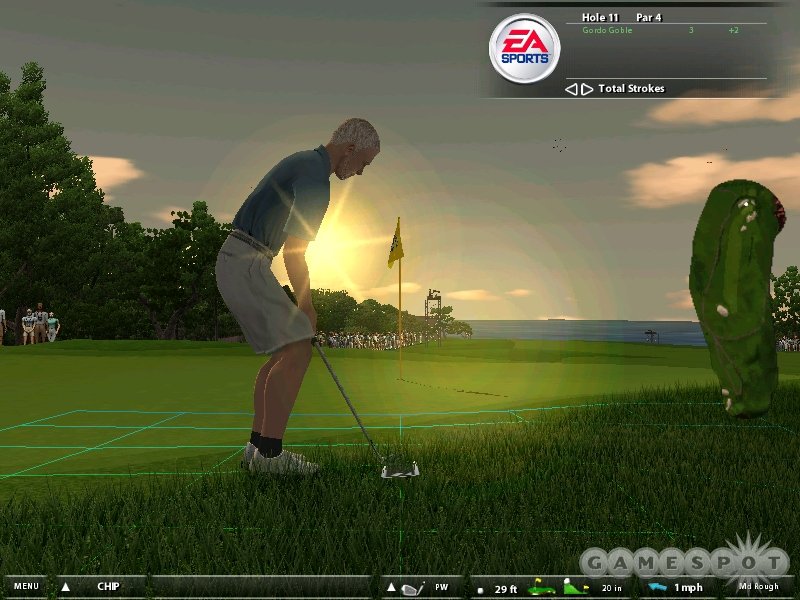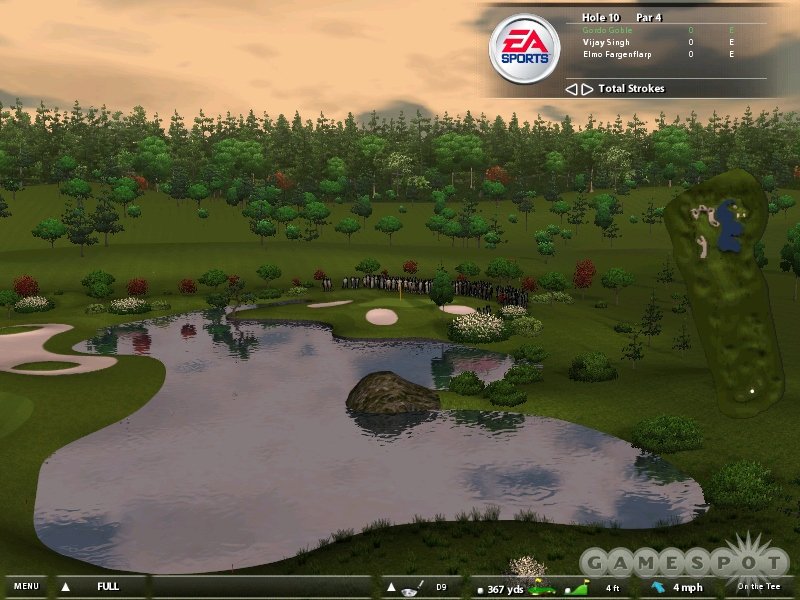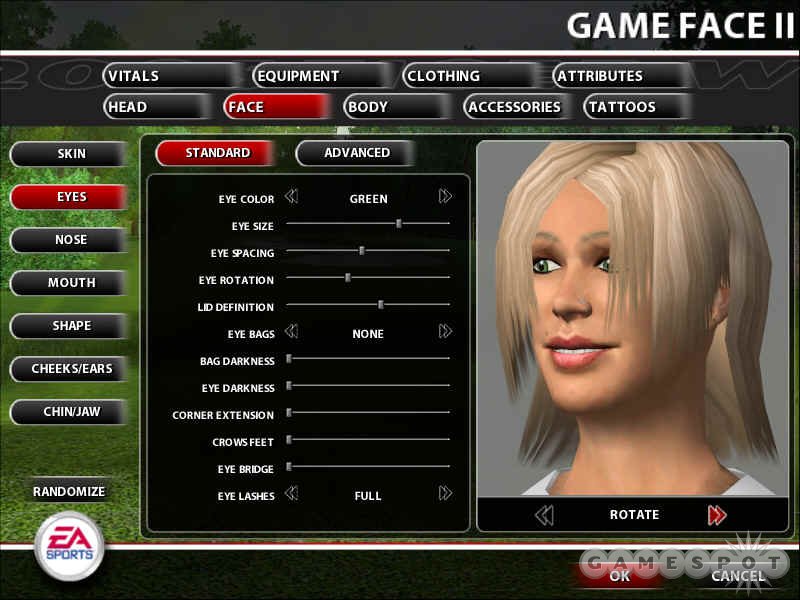Arm outstretched, Tiger Woods points defiantly toward the camera on the front panel of his latest namesake PC golfing game, thus stealing a page from the legendary Uncle Sam "I want you!" pose. But what is he really saying? "I want you...to buy this game?" or "I want you...to stop hero-worshipping Vijay?" Whatever the case, Mr. Woods remains the big box office draw despite the ageless Singh's incredible year and deserved new world number one ranking. Whether we'll one day have a Vijay Singh PGA Tour 2006 is somehow doubtful, but one thing is clear: EA Sports' Tiger Woods PGA Tour remains the uncontested champion of virtual golf, even if the man himself currently is not.

Sporting a bevy of upgrades and alterations--including a revamped Game Face utility that may have you spending more time conceiving digital players than putting them into action, the new "legends tour" mode, wherein you climb a competitive ladder to square off against such luminaries as Ben Hogan and Gary Player, and a nifty course-warping tool that custom converts even relatively sedate venues into supreme tests of skill--Tiger 2005 is more sophisticated and engaging than anything prior. Though the game doesn't introduce any serious gameplay mechanic advancements and though it remains weighed down by several quirks that become only more annoying with time, it is still computer golf's de facto standard, worthy of consideration even by those who previously purchased last year's model.
Indeed, one of the most newsworthy developments over the course of the last year is the ongoing absence of a Tiger rival. Microsoft's once-vaunted Links series hasn't seen an update since 2003 and it does not appear to be reappearing anytime soon. As for other alternatives, the horizon looks as bleak as a rainy morning at Troon. Yet even if one or more Tiger alternatives did currently exist, chances are they'd simply be too inferior to effectively battle the genre leader.
Tiger developer Headgate Studios has been designing golf games since Sierra Entertainment's 1997 release, Front Page Sports Golf. In Sierra's subsequent long-running PGA Championship Golf series, Headgate really came to life, fashioning revolutionary advancements such as the mouse-movement swing and fully animated golfers, thus proving just how entertaining and fully interactive computer golf could be. Its technical aptitude wasn't yet on par with that of the generally acknowledged top gun of the time, Access Software's otherwise comparatively staid and traditional Links, but together they lay waste to other competitors. The fact that just one of the two is currently active at least partially verifies which tactic proved to be superior.
Today, Tiger is an unparalleled smorgasbord of golfing delights that packs no less than 11 courses into its three-CD 2005 format. Granted, that's seven fewer than last year's 18-course edition, though Tiger 2005 features a total of eight brand-new courses to Tiger 2004's five. For the fantasy fans, the game features the Australian outback-inspired Red Mountain Creek and the gorgeous Asian masterpiece, Emerald Dragon. Word to the wise--venture to the latter only if you dare. It may well be one of the most difficult courses to ever emerge from Headgate. New real-life, licensed courses include California's Sherwood Country Club, South Africa's diverse Links at Fancourt, and Arizona's red rock paradise Troon North Monument course. Returning favorites include Pebble Beach, St. Andrews, and TPC at Sawgrass. It almost goes without saying that Tiger 2005 delivers virtually every form of golfing environment on the planet--and even a few that aren't.
The roster of available competitors is better than ever, though it still lacks some of pro golf's most notable standouts. Though you will find Woods, Singh, John Daly, Colin Montgomerie, and the curiously fashionable Jesper Parnevik, you won't see top-rung players such as Phil Mickelson or Ernie Els. The LPGA is also poorly represented by any stretch of the imagination, with last year's holdover Nancy Gulbis being the only participant.
Yet it's in its depiction of fantasy players that the game truly excels. Not only has Headgate supplied 14 prebuilt imaginary characters--including several that look like they should be anywhere but a golf course--but also it has provided a godlike control over the design of new personas. Deemed Game Face II, this highly addictive, in-game player-creation utility is quite possibly the finest to grace any sport game to date. The question isn't whether you want a long or a short nose or beady versus large eyes, but instead how incredibly detailed you want them to be. A nose design, for instance, will include the following parameters: nose length, width, slope, and depth; nostril height and width; the presence or lack of left and right nose moles; and the choice of four types of nostril and bridge piercings. Impressively, each alteration is displayed incrementally in real time. When you factor all the minute parameters and adjustments available in the Game Face utility--including such trivial elements as jewelry, tattoos, and even freckle or age spot density--you have literally millions of different possibilities. And that's not even counting the game's wide range of player-skill attributes.

Indeed, it's not just the stunning exactitude through which a player can be created that sells the whole routine, but the amazing humanness of each new character once he or she is on the course. Never has a golf game featured such a massive roster of believable player animations and expressive faces. That each character looks so good to begin with and so smoothly transitions from one action to another, is yet one more precedent for this already standard-setting series.
As for the world that surrounds each of your golfers, the news on this issue is both encouraging and slightly disappointing. On the upside, each environment is wonderfully "alive." Trees, foliage, and flags move with the wind. Flocks of birds soar through the sky, clouds and translucent low fog roll across the screen, and ocean waves pound against the shoreline at locations such as Pebble Beach. Lakes, meandering streams, and water hazards look lustrous and liquid, veritably glistening in the sunlight and accepting errant shots with a kerplunk and a splash. Elegant lens-flare effects materialize at the most opportune moments, framing your golfer's silhouette in the glow of the late afternoon or early morning sunshine. And, as usual, painstaking graphic detail is evident throughout.
Yet perhaps the most striking visual aspect of the Tiger series is its sense of drama. Heightened by free-roving cameras that alternate between TV-type coverage and dynamic follow-the-ball shots that could only exist in the digital world, the game delivers a consistent buzz of excitement from the first hole to the 18th. If you want to set up your own camera positions, you can do that too, choosing from an array of preset orientations or designing your own by moving, zooming, and rotating the default cam to any spot your heart desires. Dramatic sound effects and upgraded visuals accompany truly spectacular shots, and full-motion video sequences highlight key achievements.

It's generally a superb presentation, marred only by a few glitches. By far the most aggravating of these is the mysterious "warping hole," wherein the hole suddenly disappears from the screen, only to mysteriously reappear several feet away. Granted, holes transmogrified only twice during our long testing procedure, but twice is two times too many for such a perilous occurrence. It should also be noted that it was only the image of the hole that moved--the actual GPS position remained where it was, even though we could no longer see it. Very strange indeed.
Only slightly less annoying is the game's penchant for displaying inappropriate or wrongly placed shot reactions. On several occasions, we've witnessed a cheering gallery or a celebratory golfer when the shot in question was clearly a terrible effort. The opposite is also true--a gathered throng falling into stunned silence or letting loose with a perceptible groan over a near-perfect result. Furthermore, galleries generally react much too early, far before the final resting position of the ball has been established.
The same is true for the game's announcers, David Feherty and Gary McCord. The fact is that both are ideal for a computerized version of golf, given their real-life reputations and mutual senses of humor. And, certainly, the developer has armed each with a ton of phraseology to ensure minimal repetition. But both McCord and Feherty deliver many of their lines too early, before anyone in the real world would have a chance to know the result. And that, of course, makes the actual spotting of the ball anticlimactic. Almost as irritating is the dynamic duo's incredible number of errors. Conservatively, McCord and Feherty proved to be seriously mistaken at least four or five times per round, which is of course particularly vexing when you've just adhered to Feherty's erroneous advice and missed a birdie putt because of it.
Playing Tiger 2005 is an exercise in unparalleled versatility. This is a humongous game, with oodles of possibilities for rookies and veterans alike. Newcomers will likely want to avail themselves of the "new player walk-through," a text-and-graphics guide to what makes the game click. Veterans will undoubtedly gravitate to the new legend tour, where they'll move up a ladder to eventually combat icons such as Gary Payer or Ben Hogan. But the cream of the crop will certainly want to check out a little something called "tiger proofing," where they're able to transform even the tamest course into a fire-breathing monster. If you want a true postage-stamp green or ribbon-thin fairway, or perhaps a sand trap wider than a football field, this is the place to come. The eventual goal is to assemble your "Dream 18," your own personal venue constructed from your favorite--and most challenging--holes taken from all the courses.
This lengthy but involving procedure exemplifies the thinking that makes the new Tiger so compelling. In simple terms, the game grows with you. In more complex terms, virtually every Tiger element is somehow interconnected. By partaking in a tournament, you'll win money, which you can then use to buy lessons and learn new shots, enter other tourneys, buy a dream matchup in the legend tour, and much, much more. The Dream 18 is connected to tiger proofing. Good results in the game's highly structured tournament mode catch the attention of sponsors. Your stature affects your prestige, which earns you the respect of legendary golfers and attracts them to your custom-built monster course, and so on.
Curiously, the game's lessons component is not yet structured to reward truly skilled usage of your club (which could be your mouse or your keyboard, depending on whether you prefer Headgate's true-swing mode or more conventional three-click mode). One might think that in this stage of Tiger's evolution, Headgate would have developed some nifty method by which you could successfully perform a specialized shot only by enacting a deft series of motions or operations in a perfectly staged and timed sequence. But that is not yet the case. Instead, Tiger asks that you merely pay for a lesson and complete it (an easy task in anyone's book). You'll then have that given shot added to the menu bar at the bottom of the gameplay interface. Though you may need to slow your stroke a bit and position a slider before you actually attempt a tricky bump and run or flop or punch, you'll find they are generally not too far removed from a normal shot.
Of course, if you merely want a quick skins, shootout, or stroke game--or one of another dozen custom one-off game types--you can do that too. You can also opt to play against a superstar such as Woods himself, though you may want to rearrange his ability level beforehand in any of eight key skill areas so he's not quite as threatening as he otherwise might be. But the greatest threat of all may be the players you'll meet online.

Tiger 2005 sports a robust and sophisticated online multiplayer component that allows you to do just about anything you can do when you're playing against virtual competition. We were somewhat disappointed when our initial foray met with a server alert, but our subsequent experience was very positive indeed. Here you'll find no shortage of willing participants to engage you in any form of play mode you wish. And for serious players, EA Sports maintains a full stat-tracking system that includes critical information, such as money lists and league leaders. A quick warning to newbies--some dishonest players use a process called "edging" to enhance their swings. In essence, edging allows them to swing arrow-straight even at higher difficulty levels. It's cheating, pure and simple.
In the end, you really don't have much choice. If you want to play golf on your PC, there's currently just one place to turn. Fortunately, it's a great place. Tiger Woods PGA Tour 2005 is the culmination of Headgate's decade of PC golfing experience, and, with the exception of several notable quibbles and a dearth of significant gameplay mechanic innovations, it's a snappy culmination. Tiger 2005 is certainly more straight-up fun than any version of Links, and it is more involving than last year's Tiger 2004. EA and Headgate didn't exactly pull out all the stops for this edition, but they didn't rest completely on their laurels either, and that's a good thing for fans of the pastime.